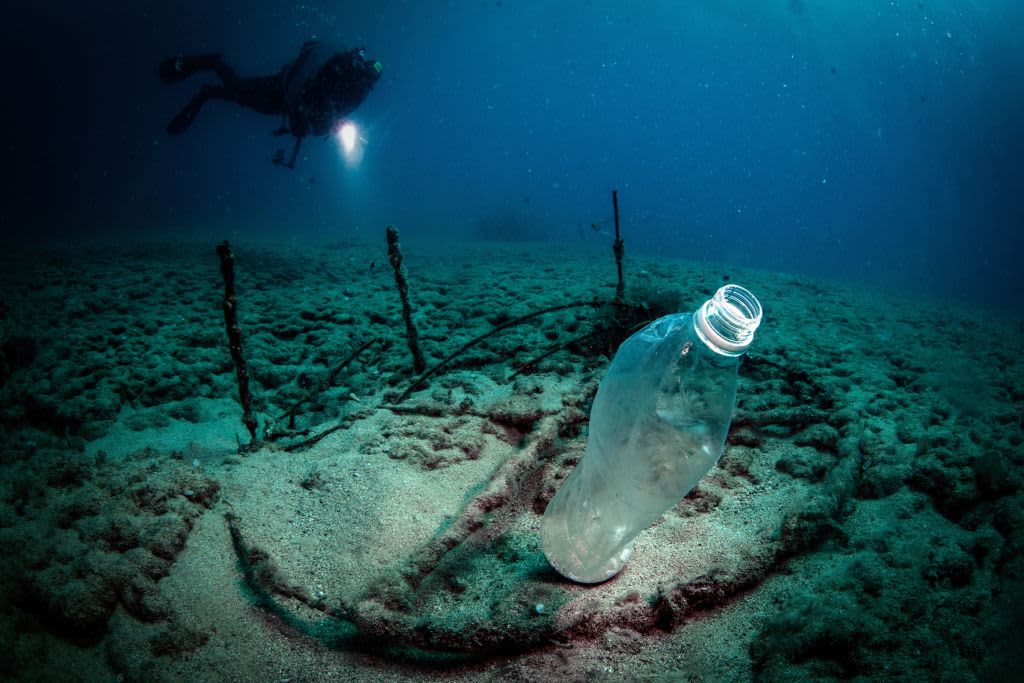
A diver with a flashlight descends into the water and flash a plastic bottle up at the Samandag diving site off the coasts of Samandag, near the Turkey – Syria border, in Hatay province of Turkey on June 04, 2019.
Sebnem Coskun | Anadolu Agency | Getty Images
Scientists from the U.K. have discovered the highest level of microplastics ever recorded on the seafloor, with up to 1.9 million pieces of plastic covering just one square meter at the bottom of the Tyrrhenian Sea, part of the Mediterranean Sea off the western coast of Italy.
The harmful plastic debris has been pulled down by powerful deep-sea currents that transport and concentrate the pollutants within huge sediment accumulations, which researchers coined microplastic hotspots.
The hotspots are a deep-sea equivalent of so-called garbage patches created by currents on the ocean’s surface.
“Almost everybody has heard of the infamous ocean ‘garbage patches’ of floating plastic, but we were shocked at the high concentrations of microplastics we found in the deep-seafloor,” said Ian Kane, a researcher at the University of Manchester and a co-author of the study published in the journal Science.
Dolphin thrown out by the waves lies on the beach is surrounded by plastic garbage. Bottles, bags and other plastic debris near is dead dolphin on sandy beach.
Andrey Nekrasov | Barcroft Media | Getty Images
Microplastics are pieces of plastic waste that measure less than five millimeters long, or often much smaller, and are deemed invisible water pollutants.
Ocean microplastics have created waste areas such as the Great Pacific Garbage Patch — a massive gyre of more than 87,000 tons of trash spanning waters from the West Coast of North America to Japan.
The tiny plastics come from sources such as textiles and clothing as well as items such as plastic bottles that break down into smaller pieces over time. The waste is not filtered out in domestic wastewater treatment plants in cities and farms, and as a result it runs right into rivers and oceans.
Researchers found that the microplastic hotspots on the seafloor can house vital ecosystems that will consume or absorb the plastics. Toxic chemicals from microplastics have been found to hurt animals such as insects and marine species by blocking their digestive systems.
Rubbish floating in Naifaru Harbour, Maldives, Indian Ocean.
Rosemary Calvert | Getty Images
The petrochemicals also pose a risk to marine ecosystems and biodiversity by disrupting the development and reproductive health of marine animals. Scientists have found microplastics in 114 freshwater and marine species.
Researchers said the new findings will help predict other undiscovered microplastic hotspot locations in the ocean and direct more research into the impact of microplastics on marine life.
The team collected sediment from the seafloor of the Tyrrhenian Sea and combined it with models of deep ocean currents and mappings of the seafloor in order to show how currents distribute microplastics.
“Our study has shown how detailed studies of seafloor currents can help us to connect microplastic transport pathways in the deep-sea and find the ‘missing’ microplastics,” said Mike Clare, a researcher at the National Oceanography Centre and a co-author of the study.
“The results highlight the need for policy interventions to limit the future flow of plastics into natural environments and minimize impacts on ocean ecosystems,” Clare said.
A biologist looks at microplastics found in sea species at the Hellenic Centre for Marine Research near Athens, on November 26, 2019.
Louisa Gouliamaki | AFP | Getty Images



